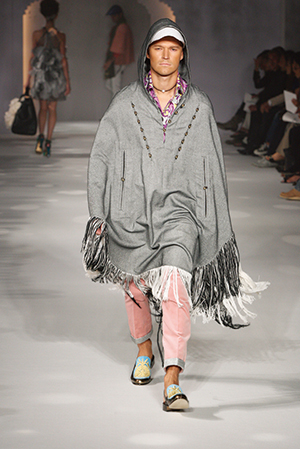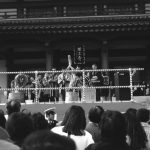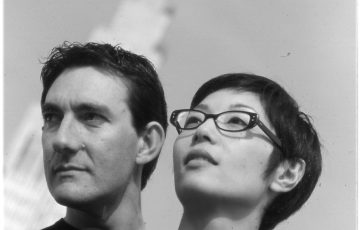 Of the previous generation of Japanese designers, Iwaya has the most respect for Hanae Mori because she was the first to have a haute couture collection in Paris. Besides, I consider myself a believer in the traditional sense of high fashion like Mori, unlike Yamamoto or Kawakubo, who are more anti-fashion renegades. But I think fashion becomes more exciting to have both styles.´′
Of the previous generation of Japanese designers, Iwaya has the most respect for Hanae Mori because she was the first to have a haute couture collection in Paris. Besides, I consider myself a believer in the traditional sense of high fashion like Mori, unlike Yamamoto or Kawakubo, who are more anti-fashion renegades. But I think fashion becomes more exciting to have both styles.´′
Fashion is obviously something that excites Iwaya who will be showing his first collection in Paris for spring 2008. Although his low-key demeanor is steadfast, and his voice always soft and melodic, looking at Toshikazu Iwaya it is hard to imagine him as anything but a fashion designer. His hair is buzzed in a short crop. He sports a brass clip on his left ear. And his clothes are stylishly paradoxical. When we met Iwaya was clad in simple jeans and a white shirt, offset by a faux fur vest and knee-high, tan suede boots with fringes cascading down the sides. Toshikazu Iwaya himself embodies his DressCamp brand: in-your-face, ultra fashionable yet curiously masculine. For my men’s wear, I simply design clothes that I would want to wear,´′he explains. Tall and broad-shouldered, Iwaya is not wispy and effeminate.
Growing up as a boy in Yokohama, Iwaya read books, watched movies and played basketball with his friends. He did not dream about being a fashion designer, although he remembers always having very particular preferences and tastes. Upon graduating from high school, he entered the Bunka Fashion College, specializing in men’s fashion. When Iwaya graduated in 1995, he did not set out to become a fashion designer right away. Instead he began working for a small textile company, AT ONES’ which is now DressCamp’s parent company.
Not everyone who attends fashion school obviously ends up being able to have their own brand. But most people I know are working in the industry in some capacity. It takes a lot of energy and commitment to start your own company. As for me, I always wanted to have my own line and I never lost track of that goal. But in the beginning, I took in everything as a learning experience. It was more important to just accomplish one task at a time, and do a better-than-expected job on everything rather than just daydreaming. ´′
It’s his unique profile and tireless work ethic that led to Iwaya’s feature on NHK’s Top Runner´′program, a show that calls on the leading figures in various fields to talk about their work in order to inspire young people. Speaking with Iwaya, one more important trait becomes clear: persistence. I don’t look at setbacks as failures,´′says Iwaya. Not everything goes smoothly all the time, but I never dwell on the negative. Setbacks are opportunities to become better. If you look at work this way, life becomes more interesting,´′he comments.
In 2002, seven years after he finished fashion design college, Iwaya’s DressCamp debuted at Tokyo Fashion Week. Iwaya says he came up with the name DressCamp because he wanted to make dresses and camp was something he thought would be light and whimsical. He says he will never forget the excitement of that first event. I was cruising all on emotions back then because I had no idea of what to expect,´′says Iwaya. It’s been a pleasure to watch my brand develop every collection.´′
It was Iwaya’s third year, at the 2005 spring/summer collection, that DressCamp rocked the fashion world and Iwaya became known as the savior of Japan’s fashion scene.´′Socialites, celebrities and general word-of-mouth buzz resulted in crowds lining up to watch his Cowboys and Indians and — Mata Hari´′collection that featured Indian headdresses, leather boots, gingham skirts, Cleopatra gold blouses and intricate floral prints.
Influential Japanese fashion critic Don Konishi lambasted the entire event, calling it an amateurish college festival where everyone just congratulated each other on a job not very well done. However, Konishi singled out DressCamp as the only outstanding brand. The bold prints and clever use of color radiates in its originality. Nothing else looked like it. No one else could do it,´′he wrote in his popular fashion website.
 Iwaya agrees with the critic that the fashion scene in Tokyo right now is light-weight. Ironically, Konishi’s endorsement garnered Iwaya extra attention, but in a way the designer didn’t care for. In Tokyo, the fashion scene is one big party. Everyone has a good time and people try to be positive all the time. It’s very difficult to tell what is truly innovative and outstanding from what is attracting celebrity attention.´′
Iwaya agrees with the critic that the fashion scene in Tokyo right now is light-weight. Ironically, Konishi’s endorsement garnered Iwaya extra attention, but in a way the designer didn’t care for. In Tokyo, the fashion scene is one big party. Everyone has a good time and people try to be positive all the time. It’s very difficult to tell what is truly innovative and outstanding from what is attracting celebrity attention.´′
Iwaya contrasts this with the Parisienne fashion scene. In France, fashion is taken very seriously. Fashion journalists are knowledgeable and evaluate each brand objectively. Professional buyers from all over the world gauge what lines will sell and what won’t. It is a highly competitive world, one where if you succeed, you know you are for real. And I love the excitement of a competitive arena,´′he explains.
At his Harajuku office, Iwaya prepares for his Paris debut systematically with his employees. If he is emotional about the occasion, he hides it well. Fashion is a business, it takes practicality and logical reasoning to succeed. If someone just wants to create a fantasy world, s/he should do theater or opera,”says Iwaya.
But he admits, For my women’s line, I add in an element of fantasy…I am sometimes fascinated by historical figures. For example I had fun using the French dancer turned spy, Mata Hari, as my inspiration to create a sensual, fantastical image for women.”
Throughout Iwayaユs career, he has collaborated with some of the worldユs top brand names, mostly those having little to do with haute couture. In 2004, he began collaborating with sportswear giant Champion, producing a line of cotton jerseys with the brandユs trademark ❝C” studded in crystal that regularly sells out. The following year, his love of crystals won him a contract to design jewelry for Piaget. In 2007, he introduced shoes and boots in collaboration with Timberland and this year, cosmetic brand MAC will introduce products designed by DressCamp. In addition to standard fashion items, Iwaya has also designed sunglasses, tableware, handbags and wedding gowns.
 ❝Although my main interest and business is clothing, it is also fun to dabble in other fields,” explains Iwaya. ❝It is always me approaching brands I like to collaborate with. I go to companies with specific ideas and most of the time, these projects become reality.”
❝Although my main interest and business is clothing, it is also fun to dabble in other fields,” explains Iwaya. ❝It is always me approaching brands I like to collaborate with. I go to companies with specific ideas and most of the time, these projects become reality.”
Iwaya is often asked to design for other companies but most of the time, he turns them down. He has a strict sense of what will turn out well and says, “I donユt want to design something that ends up looking freaky.”
The DressCamp line is available in selected designer shops in 13 countries. There are plans to open a boutique in New York City sometime later this year. Expanding his business venture is something Iwaya gets excited about. ❝Fashion is about reality,” he says. ❝When I see a small silhouette or a frill draping out of a carton box onto the floor, I see the form of a dress or the lining on a shirt. Thatユs when I think I am indeed a fashion designer. I find inspirations everywhere,” he muses. Pensive yet flamboyant, sensible and outrageousノthat such contradictory qualities can simultaneously exist in one person is perhaps why Toshikazu Iwaya is often called a genius.
Story by Carol Hui
From J SELECT Magazine, February 2009















Recent Comments